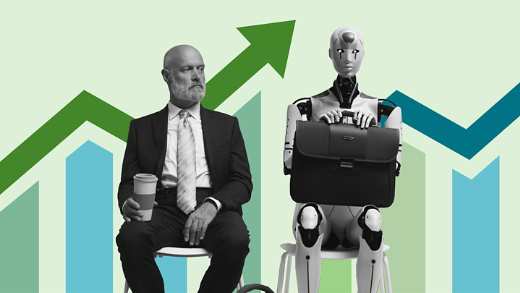- Why hold cash?
- How does inflation affect cash?
- What is the difference between saving and investment?
- How could our behavioural biases explain a reluctance to invest?
- What are the alternatives to cash or shares?
Introduction
The “dash to cash” has been one of the big investment themes of 2023. Jittery markets, coupled with higher interest rates, have led to huge flows of capital into savings deposits, cash ISAs and similar products.
Now that cash offers its best return in over a decade, it is easy to see why investors might want to hold more of it. But they should be clear about their objectives and the level of risk they can afford to take. While cash may suit the needs of some individuals or institutions, others will find longer-term investments are a better way to achieve their goals.
In this article, we explore the pros and cons of holding cash over other investments, look at some of the psychological factors that influence people’s investment decisions, and examine how a portfolio combining different asset classes and strategies can help deliver better long-term returns while spreading risk.
Figure 1: Monthly deposits in fixed-term and cash ISAs, May 2018 - April 2023 (£ billions, net)
Source: Aviva Investors, Bank of England. Data as of June 1, 2023.
Why hold cash?
Uncertainty is a fact of life, but there are times when it is particularly heightened, often for financial or political reasons. This influences the decisions people make – when they are nervous about the future, they may not have the confidence to make a big financial outlay, preferring to save instead.
To understand the current clamour for cash, it helps to think back to the global financial crisis of 2008-‘09. As panic gripped markets and economies slumped, central banks cut interest rates in a bid to bolster markets and spur growth. With rates remaining low for much of the following decade and throughout the turmoil of the COVID-19 pandemic, people had to look at other assets to earn a decent return on their money, including shares, investment funds and property.
There are times when uncertainty is particularly heightened, often for financial or political reasons
Then came Russia’s invasion of Ukraine. The war led to a spike in energy costs, pushing up inflation around the world. In response, central banks raised interest rates in an effort to mitigate rising prices. For many investors, including individuals, this new combination of market uncertainty and higher rates created a compelling case to opt for cash over riskier investments. As of July 2023, many sterling bank savings accounts yielded over five per cent, higher than at any time since the financial crisis.
For individual investors, cash has some key benefits. One is that it is “liquid”, in other words easy to buy and sell. An investor with their savings tied up in property may find it more challenging to sell readily without compromising on price. Its liquidity makes cash a good place to save for near-term expenditures, like a holiday.
Cash is also relatively safe. Bank deposits are often insured by governments up to a certain threshold. For example, the UK government will reimburse £85,000 of personal savings through the Financial Services Compensation Scheme in the rare event a bank fails and cannot repay its customers.
Cash is relatively safe. Bank deposits are often insured by governments up to a certain threshold
Some investment products are described as “cash-like”, offering a slightly higher return than simple savings accounts in exchange for taking on a little more risk. One such example is money-market funds (MMFs), which invest in high-quality, short-term fixed-income securities. Investors can get their capital back very quickly on request (often the same day). MMFs have grown in popularity among investors over the past 12 months as interest rates have risen, boosting the returns on offer.
How does inflation affect cash?
Although cash is liquid, relatively secure and currently offers a decent rate of interest, there are drawbacks. One is that it is particularly vulnerable to inflation.
It is often said inflation “erodes the value” of cash. This simply means that, as prices rise, you will be able to buy less with the same amount of money – your purchasing power shrinks. Consider an example. Imagine the Bank of England succeeds in its efforts to rein in prices and manages to consistently keep inflation at its policy target of two per cent over the next decade. In that scenario, the purchasing power of £100,000 held in sterling would fall to just over £82,000 in current terms after ten years (see Figure 2).
Figure 2: How two per cent inflation affects cash savings

Source: Aviva Investors, September 2023.
Note this example does not consider any interest received on the cash savings. If interest rates are higher than inflation rates, the purchasing power of cash can be maintained. But this is not always the case over a longer timeframe.
Figure 3 shows the average returns offered by different asset classes since the beginning of the 20th century, along with the “real return” (the return adjusted for inflation). It illustrates how cash is particularly vulnerable to the value-eroding effects of rising prices, partly because it offers a lower nominal rate of return.
For investors who need their funds to be readily available, or are saving over a relatively short timeframe, cash is useful. But the stronger returns available on bonds, equities and other investments tend to offset inflation more effectively, making them potentially more suitable for those with longer-term goals, such as building a retirement pot.
Figure 3: The impact of inflation on asset returns, 1901-2022 (per cent)
Source: Aviva Investors, Morningstar, DMS database. Data as of June 14, 2023.
What is the difference between saving and investment?
It is worth thinking about how savings and investments differ. Whereas saving involves holding assets in cash to meet short-term goals, investing is about putting money to work over a longer timeframe to take advantage of higher market returns. There are greater risks involved, and higher returns are never guaranteed. But history offers some pointers as to what investors might expect.
Investing is about putting money to work over a longer timeframe to take advantage of higher market returns
Markets are famously volatile – they soar, they crash, they bounce back. Over time, however, they tend to rise more often than they fall, with periods of growth delivering cumulative returns that can compensate for losses during downturns.
Figure 4 shows four decades of returns on the S&P 500, the stock-market index that tracks the biggest companies listed in the US. In most years, the total return (which takes into account both capital gains and any income from dividend pay-outs to shareholders) is positive despite significant intra-year market dips (as shown in the orange circles). Volatility is a normal part of equity investing.
Figure 4: Total dollar returns on the S&P 500 by year (per cent)
Past performance is not a reliable indicator of future performance
Note: Data used S&P 500 TR USD. The bars show the per cent market return in each year – most are positive, The circles show the largest per cent fall within each year – many are large.
Source: Aviva Investors, Lipper, a Thomson Reuters company. Data as of February 28, 2022.
Markets also tend to bounce back strongly after a crash, as shown in Figure 5. In the 12 months following the worst period of the financial crisis, for example, the S&P 500 rose by 68 per cent. Similarly, the index climbed 78 per cent in 2021 following the decline in markets that occurred at the onset of the coronavirus pandemic. These kinds of market fluctuations mean timing is important. Selling investments during a market slide, and missing out on the subsequent gains, can be extremely costly over the long run.
Selling during a market slide and missing out on the subsequent gains can be extremely costly over the long run
Say that you invested £100,000 in the S&P 500 in 1988. If you left the investment untouched, you would have had £4.39 million by the end of 2022. But if you had periodically withdrawn your capital over that 35-year period – perhaps because you were spooked by gloomy headlines about impending stock-market trouble – your gains would be much smaller. For example, if you had missed out on the five best trading days during that time, while otherwise remaining invested, your total pot would be worth £2.8 million in 2022. If you had missed the best 25 days, you would be left with less than £1 million.1
Figure 5: Markets often rebound strongly following a downturn (per cent)
Market falls, peak to trough
Next 12 months following fall
Past performance is not a reliable indicator of future performance
Note: Data used S&P 500 TR USD.
Source: Aviva Investors; Lipper, a Thomson Reuters company. Data as of February 28, 2022.
This shows that while investing for the long term can deliver outsized rewards, much depends on the decisions made during the life of the investment. As these decisions are made by human beings, they may be imperfect: badly timed or influenced by emotional factors. To invest successfully over the longer term, it therefore helps to be aware of the impact of psychology on decision-making.
How does psychology affect investment decisions?
Human psychology is the focus of a discipline known as “behavioural economics”. Traditional economists assumed human beings are consistently rational and logical, rather like Star Trek’s imperturbable Mr Spock. By contrast, behavioural economists have found we often make decisions that conflict with our own interests.
Experts in this field, such as Daniel Kahneman and Richard Thaler, have described many of these irrational impulses, or “cognitive biases” (see Figure 6). For example, investors often crowd into the same investments as their peers, even if doing so is financially illogical – this is known as “herd behaviour”. An increasingly connected world and the power of social media compounds this.
Behavioural economists have also found losses have a bigger emotional impact on people than gains. In a financial context, this leads them to become “loss averse”. This can be one reason why people park their money in savings accounts, even if they can afford to invest over the long term and therefore take advantage of potentially higher market returns.
Behavioural economists have found losses have a bigger emotional impact on people than gains
Another bias is known as “anchoring”, whereby investors fixate on a reference point that may be irrelevant or out of date. The rise in base rates luring investors to cash in 2023 may be one example. Five per cent looks to be an extremely attractive rate of return when compared with the low rates on offer since the financial crisis. But a longer-term view shows a UK base rate of five per cent is well within the normal historical range, as opposed to a freak anomaly to be exploited.
One way for investors to counteract their biases is to be clear about their objectives, the amount of risk they are willing to take and the timeframe over which they can afford to lock up their capital. Thaler has suggested some individuals would be best served by putting their money in a passive equity index-tracking fund and steadfastly ignoring the financial news, as a way of preventing themselves from making hasty decisions based on normal market fluctuations.
But there are other, more sophisticated investment approaches that can combine the risk-mitigating qualities of cash with the higher returns on offer in markets.
Figure 6: Cognitive biases in investing
Irrational behaviour is not just random. It is often predictable, as people tend to be prone to the same unconscious biases. More than 170 specific cognitive biases have been identified by psychologists. Here are some of the biases that are most relevant to financial professionals:
Anchoring
A tendency to anchor thinking to a reference point even when it is illogical or no longer relevant.
Availability heuristic
Overestimating the likelihood of events that are more familiar or recent, even if they are less common than unfamiliar scenarios.
Confirmation bias
Seeking out information that confirms, rather than contradicts, one’s preconceptions
Loss aversion
The pain of losing outweighs the pleasure of winning, so investors are quick to sell rising assets and reluctant to sell those falling in value.
'Hot hand' fallacy
The belief that a person who has randomly experienced success is more likely to succeed in future attempts.
Status quo bias
A desire for the current state of affairs to continue, however undesirable it is.
Hindsight bias
The tendency to believe past events were predictable at the time. This can lead to another bias, overconfidence.
Gamblers fallacy
A tendency to anchor thinking to a reference point even when it is illogical or no longer relevant.
Bandwagon effect
A tendency to replicate others’ decisions, however irrational. Also known as herd behaviour.
Source: Aviva Investors, August 2023.
What are the alternatives to cash or shares?
We all know the old adage about not keeping all your eggs in one basket. A similar principle, known as “diversification”, underpins modern investment thinking. The logic is that by spreading your assets across different markets, currencies and strategies, you are more likely to protect your capital if a problem arises, and also be better positioned to take advantage of opportunities in multiple areas.
A common approach is to combine equities and bonds in a single investment portfolio. While equities tend to offer higher returns, bonds offer more consistent income and are considered less risky (partly because a company’s bondholders are usually more likely to be repaid than its shareholders if it goes bankrupt).
A common approach is to combine equities and bonds in a single investment portfolio
Most of the time, bonds and equities have a low “correlation” with each other: this means market events that are good for equities tend to be bad for bonds, and vice versa. Equity markets may disappoint if economic growth is sluggish, but expansionary monetary policy and interest rate cuts would boost bond prices. The two asset classes can therefore complement each other in a portfolio. This is the thinking behind the traditional “60/40” portfolio, which allocates 60 per cent to equities and 40 per cent to bonds.
The optimal asset will depend on the investor’s needs, however. An individual investing in a pension in her 20s can afford to take more risk than someone approaching retirement, who will likely want to focus on preserving their capital over a shorter timeframe (see Figure 7).
Figure 7: Possible asset allocation at different life stages (per cent)
Source: Aviva Investors, August 2023.
There are further nuances to consider. Not all equities are especially risky, and not all bonds are especially safe. Within these categories, different securities can be chosen that make the overall strategy either more aggressive (or return-seeking) or more defensive (focused on preserving capital). Other asset types can also be added into the mix – including cash. This is known as a “multi-asset” strategy, and it can offer a bridge between holding cash and investing purely in equities or bonds, allowing investors to find a balance that works for them.
A “multi-asset” strategy can offer a bridge between holding cash and investing purely in equities or bonds
Investors might have other outcomes they want to achieve. Perhaps they would like to avoid financing the coal industry, or ensure their money supports companies that are progressive on social issues. These kinds of goals can also be achieved through investing in certain multi-asset strategies, where their managers take steps to exclude highly polluting firms and engage with companies to bring about improvements on environmental, social and governance (ESG) issues.

















